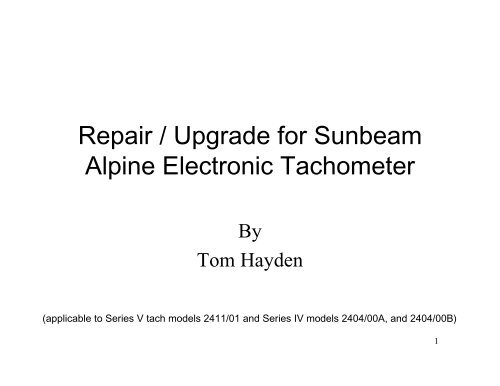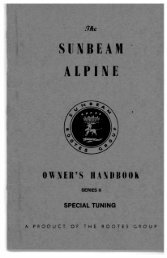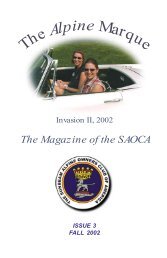Repair / Upgrade for Sunbeam Alpine Electronic Tachometer
Repair / Upgrade for Sunbeam Alpine Electronic Tachometer
Repair / Upgrade for Sunbeam Alpine Electronic Tachometer
Create successful ePaper yourself
Turn your PDF publications into a flip-book with our unique Google optimized e-Paper software.
<strong>Repair</strong> / <strong>Upgrade</strong> <strong>for</strong> <strong>Sunbeam</strong><br />
<strong>Alpine</strong> <strong>Electronic</strong> <strong>Tachometer</strong><br />
By<br />
Tom Hayden<br />
(applicable to Series V tach models 2411/01 and Series IV models 2404/00A, and 2404/00B)<br />
1
Disassembly:<br />
The first step is to disassemble the tach by removing the chrome ring and glass. This is done by rotating<br />
the chrome ring until the tabs line up with the slots in the case. It may be helpful to use a rubber pad such<br />
as used in the kitchen <strong>for</strong> removing tops of pickle jars. It may also help to bend the tabs slightly upward,<br />
but be careful so as not to distort the ring. Remove the ring, the glass, and the inside bezel.<br />
Next remove the 2 screws holding the assembly into the housing and carefully drop the assembly into your hand<br />
It may be helpful to review other articles such as the following to gain understanding about these tachs:<br />
http://www.classictiger.com/techtips/motach.html<br />
2
Replace aged, defective, unstable components:<br />
I have analyzed and repaired 10 of these tachs and this instruction is based on that experience. I have not<br />
seen a single transistor fail, but the referenced article describes suitable replacements if that is the<br />
problem. The repairs I describe resolve all the problems I have seen to date, except <strong>for</strong> 2 tachs that had<br />
failed meter movements- the coil was open. I have not found any way to repair a tach with this problem.<br />
I strongly recommend that all the component replacements I suggest be done. I have been amazed at how<br />
far these parts have shifted over time. Granted these are over 40 years old, but I had not previously realized<br />
in my electronic engineering experience how badly some of these parts will shift with age. Many have<br />
shifted 50 to 100% from the original value. On no units have I seen any significant change in the 56 ohm<br />
(not 55 as shown in the schematic) resistor R2, so I see no reason to replace it. It is one of the few high<br />
quality parts used in the original.<br />
I did considerable research and testing on the thermistor and temperature compensation. I determined that<br />
the thermistor is used to provide temperature compensation to compensate <strong>for</strong> the temperature coeffient of<br />
the copper coil in the meter, which would cause the meter to read low when warmer than the temp at which<br />
it was calibrated. This is because the output of the electronic circuit is a voltage, whereas the meter<br />
responds to the average current. When the copper coil resistance increases as the temperature goes up (by<br />
about 0.4% per deg C) the current through the meter is reduced due to the higher resistance. I have<br />
measured 5 thermistors from various <strong>Alpine</strong> tachs, and find they ranged from 150 to 175 ohms at 25C. It is<br />
difficult to tell what the original values were, but I strongly suspect that all the original thermistors have<br />
drifted far from their original values. From tests I conducted on those 5 thermistors I have determined that<br />
their present characteristics actually overcompensate such that all tachs read significantly high when<br />
warm. I have found a commercially available thermistor with a 300 ohm (@25C) that when combined with<br />
34 ohms in series with it provides nearly perfect temp compensation.<br />
In addition to the time drift of the various parts, many also have significant temperature drift which adds to<br />
instability and inaccuracy, which is why I replace several additional parts.<br />
3
We need to replace:<br />
•C2 with a new 0.22 uF cap<br />
•R3 with a more stable modern Res 1.24 k<br />
•R5 with a higher value modern Res 9.31 k<br />
•R7 with a new, more stable, 150 Ohm<br />
•R8 with a new stable 3.3 Ohm<br />
•Old Thermistor with a combination,<br />
new (300 Ohm / 3900K) thermistor plus<br />
34 ohms<br />
New Thermistor<br />
or<br />
470<br />
34<br />
4
Original assembly<br />
R5<br />
Replace with new 9.31 K<br />
R3<br />
Replace with new 1.24 K<br />
C2<br />
Replace with new 0.22uF<br />
R8<br />
Replace with new 3.3<br />
Thermistor<br />
Replace with new series combination<br />
Thermistor Plus 34 ohms<br />
R7 Replace with a new 150 Ohm,<br />
2 watt resistor .<br />
Clean the whole assembly<br />
Especially the magnet<br />
CAREFULLY!<br />
Use artists paintbrush and<br />
Q-Tips, dipped in alcohol<br />
5
Notes:<br />
Removing C2, R3, R5, R7, R8 is easy. Their ends may be bent over but still removal should not be difficult.<br />
But removing the thermistor may be more difficult because one end may be soldered into the same hole as the<br />
56 ohm resistor and the other end is soldered into a hole almost under the 56 ohm resistor.<br />
When installing the new combination of thermistor and 34 ohms it may be simpler to just tack solder the left<br />
end (as viewed in the photo) of the combination to the junction post with the black wire soldered to it. This is<br />
the same electrical point as the hole almost under the 56 ohm resistor.<br />
I find it quite possible to make these changes without removing the dial or needle. When working on the top<br />
side (as shown in the photo) the assembly is easily supported resting on its back side. But when working on<br />
the back side of the board, where the solder and circuit traces are, I find it very handy to support the tach on<br />
its dial face by setting it, face down, on the edges of a small box with no top- a small box like a jewelry box<br />
with its lid off. Set the tach so the dial face rests on the edges with the needle free to swing and pivot<br />
somewhat. Do not set the tach face down on the needle on a hard surface.<br />
6
Notes:<br />
The reason <strong>for</strong> replacing R5 with a 9.31k is to reduce the adjustment range of the adjuster and increase the<br />
stability of the timing. An old adjustable resistor as used in this tach is not very stable over time or<br />
temperature, so reducing its effect reduces the drift. This also reduces its adjustment range, which is not a<br />
problem as long as the tach is used <strong>for</strong> a 4 cyl engine. The value of this resistor is not critical. Any value from<br />
about 3k to 15k will probably be OK because the adjustable resistor sets the actual total resistance and the<br />
combination of C2 and this resistance determines the pulse width of the pulse train. But the resistor should be<br />
one with a good temperature stability. And the larger the value used <strong>for</strong> R5, the less resistance from the<br />
variable resistor is used, and the better the temperature stability of the pulse width and thus the overall<br />
accuracy.<br />
CLEAN THE ASSEMBLY!<br />
It is also important to clean the assembly and the case. The clearances between the moving coil and the<br />
circular magnet are very close. In many tachs I have found metal shaving and almost always paint flakes. This<br />
debris will cause stickiness in the meter movement and results in inaccurate RPM readings. I use artists<br />
paintbrushes and Q-Tips dipped in alcohol to carefully clean everything.<br />
7
<strong>Upgrade</strong>d assembly<br />
R3 new 1.24 K<br />
R5 new 9.31 K<br />
C2 new 0.22uF<br />
R8 new 3.3<br />
New 34 ohms<br />
In series with<br />
Thermistor<br />
New Thermistor<br />
R7 new 150 Ohm,<br />
2 watt resistor .<br />
8
Add a calibration access hole:<br />
Be<strong>for</strong>e installing the assembly into the housing I suggest drilling a 3/16” (or so) hole in the rear of the case to<br />
provide access to the adjustment pot. This allows adjustment of the tach after it is mounted in the case.<br />
Otherwise there is a slight shift In calibration after mounting in the case.<br />
Be sure to put tape or other means over the hole after calibration to keep out moisture, dirt, dust, and bugs<br />
0.5” from<br />
Edge to ctr of new hole<br />
0.41” from<br />
Edge to ctr of new hole<br />
9
O-Rings:<br />
Use the 2 new thick (0.10”) O rings to mount the glass and chrome ring. One ring fits exactly as is into the<br />
chrome ring.<br />
The other O-Ring requires cutting out a segment (approx ½”) to allow it to fit snugly into the bezel<br />
There is a third O-Ring, thinner in cross section, that goes outside the case and acts a a gasket between the<br />
housing flange and the dash panel. These were installed on all <strong>Alpine</strong>s, but I am not sure how necessary they<br />
are.<br />
10
After installing the assembly into the case and reattaching the bezel, O-Rings, glass, and chrome ring, You can<br />
apply a signal to the tach to calibrate it.<br />
If you are using a signal generator (typically with 50 ohm or 600 ohm output impedance) to calibrate the tach<br />
you will need to wind 15 to 30 turns of small gauge wire around the U-shaped steel clip in order to couple a<br />
large enough signal in.<br />
If you are using the actual ignition signal to calibrate the tach you can just wind a couple turns of the ignition<br />
wire through the clip. You do not need to use the plastic piece that is installed in the white wire. For some<br />
tachs I have seen a need to wind an extra turn, one more than the 1-1/2 turns originally used, in order to get<br />
the tach to respond. It’s easy to do if you don’t use the plastic piece.<br />
Note that in order <strong>for</strong> the tach to respond to the ignition pulses, BOTH tips of the little U-shaped steel clip must<br />
be in good contact with the mating tip protruding through the case from the other half of the trans<strong>for</strong>mer<br />
inside.<br />
11
Tach Replacement Parts<br />
Description Digi-Key P/N<br />
1 C2- 0.22 uF Cap, 100 VAC 495-2492-ND<br />
(yes, this tiny part is the replacement <strong>for</strong> the big brown part)<br />
2 R3- 1.24k Resistor CMF1.24KQFCT-ND<br />
3 R5- 9.31k Resistor CMF9.31KQFCT-ND<br />
4 R 7 - 150 Ohm resistor 2 W, (Large) 150W-2-ND<br />
5 R 8 - 3.3. Ohm res (orange-orange-gold-gold stripes) 3.3QBK-ND<br />
6 Thermistor – 300 Ohm (3900K) PNT109-ND<br />
7 Series resistor <strong>for</strong> adding to thermistor – 34 Ohm CMF34.0HFCT-ND<br />
8 Rubber O-Rings, 2ea. 0.100” , cross section, Use one <strong>for</strong> under the chrome ring. Cut<br />
second one to fit under the glass, inside the black metal bezel.<br />
9 Rubber O-Ring , 1 ea, 0.070”cross section. Use as the dash mount gasket- goes outside the<br />
tach housing.<br />
I have assembled kits of the above parts <strong>for</strong> those wishing to upgrade their own tachs.<br />
In addition some may find they need these additional parts and I have identified them here but<br />
are NOT included in my kits :<br />
• 6.2V zener diode 1N4735ADICT-ND<br />
• R2, 56.0 ohm P56.0CACT-ND<br />
• Q1 or Q2 PNP Ge Transisitors ???? Maybe use a modern Silicon type<br />
12
“Sticky” needles:<br />
I have seen several cases where the needle seemed a bit sticky. That is, it did not move smoothly over the full<br />
range of indications. I have read various posts by other <strong>Alpine</strong> owners about similar problems. Assuming you<br />
have cleaned the mechanism and especially the area around the magnet and moving coil, I have found that in<br />
most cases this is a case of insufficient end play in the needle pivot. If you have a sticky needle, grab the<br />
center “knob” of the needle and push-pull it in and out from the dial. It should have some slight play (about<br />
0.003”), just enough to be observable. If there is no end play you can adjust the end bushing. First remove the<br />
needle. I find the best way to remove the needle is by using a pair of small jewelers screwdrivers inserted from<br />
opposite sides with their tips touching the dial under the needle “knob” where any scratches from the tips will<br />
not show after the needle is reinstalled. Pry evenly on both sides and the needle will pop off. Once the needle<br />
is off you need to use a split tip screwdriver as shown in the picture. You can make one by grinding a slot in<br />
the tip of a regular, small screwdriver<br />
The slot does not need to be as deep as the needle pivot since you can make the adjustment with the<br />
screwdriver at an angle. You’ll only need to turn the adjustable bushing about 1/8 of a turn to make it loose<br />
enough to eliminate sticking.<br />
When replacing the needle just press it on to the pivot pin. Initially install it slightly above the “0” position<br />
and don’t press it on very hard. Then rotate it into final position at “0” and then press it a bit more firmly on<br />
with just finger pressure .<br />
13
Positive Earth:<br />
The above presentation is based on the Model 2411/01 tachs used on all series V <strong>Alpine</strong>s. These are all<br />
Negative earth tachs. There were several versions of Pos earth tachs used on Series IVs, including model<br />
2404/00, 2404/00A, and 2404/00B.<br />
The 2404/00 fitted to early SIVs is significantly different from all later tachs and some lack the internal 6 V<br />
zener diode regulator and thus can have substantial errors due to variation of battery/generator voltage. I<br />
recommend replacing the tach or the electronics on these units. The meter movement is the same in all.<br />
I have also found several variations on component layout even within the same model number, so your tach<br />
may not look exactly the same as my photos show.<br />
The 2404/00A and 2404/00B fitted to later SIVs are nearly identical to the 2411/01 described in this article<br />
except <strong>for</strong> the values of R6 and R7, which are not critical, and <strong>for</strong> the fact that they are wired as Positive earth.<br />
The photo shows what a Pos earth wired unit looks like. In fact this is the electronics from a 2411/01 Neg earth,<br />
SV tach, that has been re-wired to be Pos earth. The only differences are the swapping of the green wire and<br />
the end of the large resistor, R7. If you have a 2404/00A or 2404/00B and wish to convert it to Neg earth simply<br />
swap the 2 connections, moving the end of the resistor to the tab on the left and moving the green wire to the<br />
tab on the right (R&L as viewed in this photo)<br />
Tach wired <strong>for</strong> Positive Earth<br />
14
Accuracy :<br />
Some have described the accuracy of these tachs across the RPM range as not too good. I disagree. With<br />
good stable parts and properly calibrated they are quite good. Every one I have repaired and calibrated will<br />
track as accurately as originally designed. You can see the original accuracy “specs” by looking at the dial. On<br />
the Series V tachs you will see tiny marks just outside the “hash marks” at 1500, 4000, and 6000 RPM. I<br />
assume the tach was adjusted at 1500 and then checked at 4000 and 6000, then readjusted if necessary until<br />
the readings were within the noted marks. That would put it within 100 RPM at each cal point. Earlier (positive<br />
earth) tachs were cal’d at 1300, 3500 and 5200 RPM.<br />
Here is a typical calibration table from a tach I have restored and calibrated:<br />
Adjusted the tach <strong>for</strong> best compromise over the full operating range.<br />
Operated the tach <strong>for</strong> 5 minutes warm up be<strong>for</strong>e doing final cal.<br />
Settings and readings (after 5 min operating warm-up):<br />
Applied Freq Equiv RPM RPM Reading displayed<br />
30 Hz 900 900<br />
40 1200 1220<br />
50 1500 1450<br />
60 1800 1740<br />
80 2400 2350<br />
100 3000 2950<br />
120 3600 3580<br />
150 4500 4520<br />
180 5400 5400<br />
200 6000 6000<br />
15











